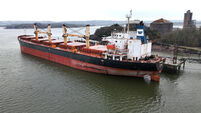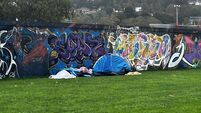Cormac O'Keeffe: Production — and seizures — of cocaine continue to reach record levels

The Matthew cargo ship which was boarded by Army Rangers, Gardaí and the Naval Service passing Roches Point as it comes in to Cork Harbour. Picture: Dan Linehan
It’s almost 15 years ago since Castletownbere was at the centre of one of the country’s biggest ever cocaine hauls.
The Dances with Waves yacht was escorted under armed guard into the fishing port and its 74 canvas-wrapped bales of cocaine, weighing 1.5 tonnes, were put on display.
In horrendous weather conditions in November 2008, the yacht had experienced engine problems and was on the verge of capsizing with its cargo when naval officers boarded it some 240km off the Mizen coast.
The load was initially thought to be the largest cocaine haul in Ireland, but it was just under the 1.575 tonnes seized in Dunlough Bay in West Cork in July 2007.
Castletownbere is again in the media spotlight after a local trawler, recently sold in good faith, was taken to sea on Saturday by two men believed to have been in the town for a number of days.
A day and a half later, the vessel ran aground on a sandbank off Blackwater, Co Wexford, with suspected cocaine on board.
The vessel had been the target of a Garda-Naval Service-Air Corps surveillance operation.

It is thought the vessel had a rendezvous with a bulk cargo ship, the suspected “mother ship”, which was carrying the drugs and took a consignment.
The trawler was then expected to travel on to England, when it experienced problems.
While the Joint Drugs Task Force — comprising gardaí, Defence Forces and Customs — were organising bringing the trawler into port, a related operation was under way to storm the cargo ship that originally carried the drugs.
The elite Army Ranger Wing boarded the ship off the Cork/Waterford coast on Tuesday afternoon and naval officers took control.
Gardaí said a Panamania-registered bulk cargo vessel originating in South America was detained and "a significant quantity" of drugs were located onboard.
They said the operation was conducted in collaboration with the Maritime Analysis and Operations Centre (MAOC) based in Lisbon, and partners from the National Crime Agency, the Drugs Enforcement Agency, and French customs service DNRED.
As the various arms of the Irish investigation continue to unfold, the operation highlights, once again, the scale of the cocaine trade traversing the Atlantic.
It recent years the size of loads coming across from South America has increased sharply.
Last Monday, French navy assets seized 2.4 tonnes of cocaine off the west African coast, bound for Europe.
Last week, MAOC and Brazilian police together seized 3.6 tonnes of cocaine in the Atlantic.
At the start of this month, Spanish police seized 2.7 tonnes of cocaine off the Canary Islands.
In August, Dutch authorities made their biggest ever seizure of cocaine, when eight tonnes were found in Rotterdam port.
In July, 10 tonnes of cocaine were seized in Hamburg, a German record.
In the same month, Italian agencies seized over five tonnes of cocaine off the Sicilian coast and 6.8 tonnes was seized in Brussels, Belgium.
After the two record cocaine seizures in Ireland in 2007 and 2008, the next major cocaine shipment was in September 2014, when one tonne of cocaine has found inside the Makayabella yacht off the Cork coast.
All those three consignments were organised by British traffickers and the bulk of the cocaine destined for Britain.

The cocaine trade has changed beyond comprehension since 2014.
As the United Nations Office on Drugs and Crime (UNODC) reported last March, the amount of cocaine manufactured in 2020 was more than twice the amount in 2014 and that, ever since 2017 the record has been broken.
The surge in cocaine supply is down to an expansion in coca bush cultivation, improvements in production and a continuing growth in demand, particularly in Europe.
The UNODC said seizures by law enforcement have also increased to record levels, at a higher speed than production, suggesting it had “contained” the problem.
The seizures in Ireland back up this trend, with Brexit being an additional factor driving container traffic, including cocaine, into Rosslare and Dublin.
On August 5, 60kgs of cocaine was found inside a freight container at Ringaskiddy Port, Cork.
The day before, the reported that Revenue had seized 400kgs of cocaine so far in 2023, compared to 133kgs in 2022.
It included a 163kg haul in Rosslare, linked to Balkan cartels, and a 133kg seizure in the port, both in July.
The UNODC reports an “increased presence” in Colombia of Mexican and Balkan cartels, with the aim of making “supply lines more efficient”.
The agency notes a “strong increase” in 2021 in the quantity of cocaine seized in Europe, including in a range of smaller ports across northern Europe and also in Ireland — Dublin, Rosslare, and Cork ports.
The European Drugs Agency reported last June that cartels, in a bid to avoid tighter security at major ports, were targeting smaller ports —
and that this “may well” include Ireland.
















